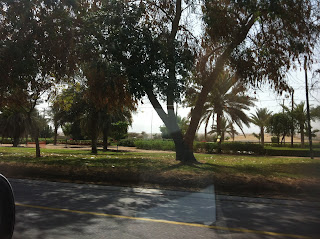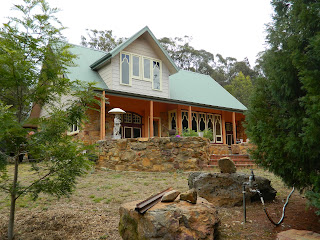I wear a veil in public these days. Not because I have to, indeed quite a few people (mostly non Omani) people have said that I don't have to, but I feel more comfortable wearing one. There is, I think, a subtle difference in the way people interact with me when I'm wearing it. Maybe I'll keep wearing it, maybe in time I won't. However, for the moment I shall continue as is.
Oman certainly is the place to see veils. There are all kinds, covering more or less of the wearer. From delicate bits of floral chiffon draped artfully over truly enormous hair to the completely black, head to toe burqa. I'd love to run around snapping pictures to show you the variations, but it's a little bit (read a lot) rude. Besides, I don't have enough Arabic to ask politely enough. May be when i do have enough Arabic I'll create a photo essay; after the T thing of course. In the meantime you'll just have to deal with a written description.
I'd love to snap the gaggles of teenagers. Teens are teens in any culture. Take the mall for instance. Muscat City Centre is the biggest mall in Muscat, well until the bigger mall opens closer to the centre of town. In comparison to even Australian malls that's not saying very much, but the similarities are alive and well. Large groups of mid-teen boys, in pristine white dishdashas (a close necked, long sleeved, ankle length dress) and closely embroidered kumas, swagger and pose when they see equally large groups of giggling mid-teen girls swathed in black from head to toe with flashes of bright decorations swirling around hems, wrists and heads. If I close my eyes I could be back at Belconnen mall on a weekday afternoon.
There are a some very distinct styles of dress for the young Omani lass (These are my observations only and any connection to fact may be tenuous, I don't know the ins and outs of groupings here yet). The abaya is reasonably universal, and has varying degrees of adornment, some of it gently bright embroidery and some outrageous bling that dazzles the eye. It is the veil that is different.
Some ladies just where a simple scarf or pashmina around their heads. Colour is up to the individual and there is plenty of it. Florals and paisley styles are the go, the brighter the better. Some westerners (including me) dress like this. Although I'm not a bright colour sort of girl. These are worn over black abayas, coloured robes or western clothing.
There is the large head, little body look. Sort of Italian renaissance in reverse. In this style the hair is pulled back into a tight bun and held in place with a claw comb which is liberally adorned with fabric flowers. Lots of fabric flowers. Lots and lots of flowers. The decorated comb ends up about the size of a human head and then it, and the actual human head it's attached to, is draped liberally in several black veils, leaving a tiny, white, heavily made up face peaking out at the world. Make up is very important to the Omani lass. Eyes are heavily kohled, thick, perfect eyebrows are painted on (even to the extent of delicate shading across the bridge of the nose in what is unkindly known in western society as a mono-brow). It is this group that sometimes wear their veils completely covering their faces - unless they're eating ice-creams. Apparently ice-cream negates the need to cover your face in public - at least for some of the teenage girls I've come across.
Then there is the burqa. Those women who wear the burqa do not subscribe to the large head, little body attitude on life. These ladies waft through the crowd with an elegant ease. All you can see is brown, luminous eyes. Not a dark, dark brown like my boy's a little lighter. It is easy to see them smile and laugh, as well as being stern with their children. The burqa really brings home the old adage that 'the eyes are the windows of the soul.' Don't for one instant think that these women are subservient or shy. Standing next to one young lady and her daughters (who were groovin' to the beat in the electronics store and staring at the strange western lady) I could see some tantalisingly beautiful henna swirls and arabesques painted round her eyes. Her hands were also covered in intricate patterns and her finger tips were tipped with henna. All in all, breathe takingly beautiful and exotic. Henna designs are common here on hands and arms, but not so much on the uncovered face.
Then there is the Effie-style of dress. Remember Effie? A Greek lassie with enormous hair? Well, she's alive and well and living in Oman. Her hair is huge and stiffened to within an inch of it's life, her scrap of veil (a sort of passing nod to tradition) draped artistically over her gargantuan "bun." Her clothes are not what one would call concealing, she's got it and it's on show. Her nails are long and brightly painted, her heels high and tiny.
All of these ladies make up just one part of the colour of the Omani street. I have to say, if you are concerned that women are being downtrodden by the requirement to wear a veil, come to Oman for a thirty second tour of the mall. You'll change your mind very, very quickly. Here the veil is more than just a head covering. It is a language, an art, but most importantly, it is a personal statement of a woman's individuality.
Oman certainly is the place to see veils. There are all kinds, covering more or less of the wearer. From delicate bits of floral chiffon draped artfully over truly enormous hair to the completely black, head to toe burqa. I'd love to run around snapping pictures to show you the variations, but it's a little bit (read a lot) rude. Besides, I don't have enough Arabic to ask politely enough. May be when i do have enough Arabic I'll create a photo essay; after the T thing of course. In the meantime you'll just have to deal with a written description.
I'd love to snap the gaggles of teenagers. Teens are teens in any culture. Take the mall for instance. Muscat City Centre is the biggest mall in Muscat, well until the bigger mall opens closer to the centre of town. In comparison to even Australian malls that's not saying very much, but the similarities are alive and well. Large groups of mid-teen boys, in pristine white dishdashas (a close necked, long sleeved, ankle length dress) and closely embroidered kumas, swagger and pose when they see equally large groups of giggling mid-teen girls swathed in black from head to toe with flashes of bright decorations swirling around hems, wrists and heads. If I close my eyes I could be back at Belconnen mall on a weekday afternoon.
There are a some very distinct styles of dress for the young Omani lass (These are my observations only and any connection to fact may be tenuous, I don't know the ins and outs of groupings here yet). The abaya is reasonably universal, and has varying degrees of adornment, some of it gently bright embroidery and some outrageous bling that dazzles the eye. It is the veil that is different.
Some ladies just where a simple scarf or pashmina around their heads. Colour is up to the individual and there is plenty of it. Florals and paisley styles are the go, the brighter the better. Some westerners (including me) dress like this. Although I'm not a bright colour sort of girl. These are worn over black abayas, coloured robes or western clothing.
There is the large head, little body look. Sort of Italian renaissance in reverse. In this style the hair is pulled back into a tight bun and held in place with a claw comb which is liberally adorned with fabric flowers. Lots of fabric flowers. Lots and lots of flowers. The decorated comb ends up about the size of a human head and then it, and the actual human head it's attached to, is draped liberally in several black veils, leaving a tiny, white, heavily made up face peaking out at the world. Make up is very important to the Omani lass. Eyes are heavily kohled, thick, perfect eyebrows are painted on (even to the extent of delicate shading across the bridge of the nose in what is unkindly known in western society as a mono-brow). It is this group that sometimes wear their veils completely covering their faces - unless they're eating ice-creams. Apparently ice-cream negates the need to cover your face in public - at least for some of the teenage girls I've come across.
Then there is the burqa. Those women who wear the burqa do not subscribe to the large head, little body attitude on life. These ladies waft through the crowd with an elegant ease. All you can see is brown, luminous eyes. Not a dark, dark brown like my boy's a little lighter. It is easy to see them smile and laugh, as well as being stern with their children. The burqa really brings home the old adage that 'the eyes are the windows of the soul.' Don't for one instant think that these women are subservient or shy. Standing next to one young lady and her daughters (who were groovin' to the beat in the electronics store and staring at the strange western lady) I could see some tantalisingly beautiful henna swirls and arabesques painted round her eyes. Her hands were also covered in intricate patterns and her finger tips were tipped with henna. All in all, breathe takingly beautiful and exotic. Henna designs are common here on hands and arms, but not so much on the uncovered face.
Then there is the Effie-style of dress. Remember Effie? A Greek lassie with enormous hair? Well, she's alive and well and living in Oman. Her hair is huge and stiffened to within an inch of it's life, her scrap of veil (a sort of passing nod to tradition) draped artistically over her gargantuan "bun." Her clothes are not what one would call concealing, she's got it and it's on show. Her nails are long and brightly painted, her heels high and tiny.
All of these ladies make up just one part of the colour of the Omani street. I have to say, if you are concerned that women are being downtrodden by the requirement to wear a veil, come to Oman for a thirty second tour of the mall. You'll change your mind very, very quickly. Here the veil is more than just a head covering. It is a language, an art, but most importantly, it is a personal statement of a woman's individuality.















































